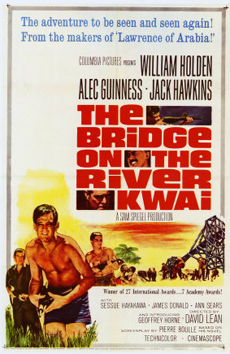The prisoners are being forced to build a bridge over the River Kwai,
in order to complete a supply line to be used by the Japanese. At the
beginning movie, few prisoners survive, and Shears is determined to
stay on sick leave as long as possible, to avoid the backbreaking labor
that could lead to his death.
Then, a captured British unit arrives, led by the particularly determined
Colonel Nicholson (Alec Guinness), who immediately gets into a battle
of wills with the head of the POW camp, Colonel Saito (Sessue Hayakawa).
Eventually, under the British commander's example, the prisoners rally,
building a bridge that Colonel Nicholson begins to see as an opportunity
to build morale among his troops and to serve as a lasting testament
to the capabilities of the British soldier.
In the meantime, Shears, who has escaped, finds himself drafted to
lead a small group of soldiers back to the prison camp, with the goal
of blowing up the bridge.
The action of the film, like the book, is loosely based on the true
story of Lieutenant Colonel Philip Toosey and his confrontations with
the real-life Saito. The real-life Saito was much more reasonable than
portrayed in the movie, and Toosey spoke up on Saito's behalf at the
war-crimes tribunal after the war, saving him from the gallows. The
author of the book had been a prisoner of war in Thailand and based
Colonel Nicholson on various French officers.
The Bridge on the River Kwai is remarkable for being one of
the first postwar films to depict the Japanese as anything other than
two-dimensional. Colonel Saito is prideful, yes, but subject, just as
the British soldiers are, to the will of his commanders. Hayakawa portrays
him as a man whose rough exterior hides a vulnerable side, as he copes
with warring internal forces, forced to compromise his own principles
in order to please his superiors.
The three-hour movie falls neatly into two halves: the first half being
the contest of wills between the two officers and the second half being
the building of the bridge. Thus, the first half is much darker, with
the second half feeling almost like a dark comedy. It's almost a combination
of two types of war movies: the type that depicts a hero rising about
a devastating trial, and a satirical examination of the human foolishness
and pride that always enters into human conflict.
Guinness is perfectly cast as the British commander. Though not a physically
imposing man, he projects a confidence in his erect posture and clipped
voice that makes his Colonel Nicholson a force with which to be reckoned.
Likewise, Holden is well cast as the American who has a brash sort of
appeal but turns out to be a very complicated character.
If the screenplay writer, Carl Foreman, had his way, Humphrey Bogart
would have played Shears, but Columbia Studios refused to allow Bogart
out of another project. Cary Grant was briefly considered as Colonel
Nicholson, but he had flopped in a serious role in the 1950 movie, Crisis,
which concerned producer Sam Spiegel. The role was offered to both Charles
Laughton and Laurence Olivier, who turned it down. Even Guinness initially
passed up the role, saying, "I can't imagine anyone wanting to
watch a stiff-upper-lip British colonel for two a half hours."
Fortunately, he reconsidered.
David Lean, whose final film, A Passage to India, would earn
him another Oscar nomination (though not a win), was not the first choice
to direct. Howard Hawks was asked but declined, fearing a box-office
failure
Screenwriters Michael Wilson and Carl Foreman were on the black list
and thus went uncredited, with the sole writing credit going to Pierre
Boulle, who wrote the original novel in French. Thus, Boulle won the
Oscar for Best Adapted Screenplay, even though he spoke no English!
In 1984, the Oscar was retroactively awarded to Wilson and Foreman,
although Wilson did not live to see it. Foreman died the name after
it was announced. When the film was restored, their names were added
to the credits..
Shot on location in Ceylon, in a lush landscape, the film easily evokes
the time and place of the story. Shooting it on a sound stage would
have been next to impossible. Hundreds of Asian extras also help with
the authenticity. The bridge cost $250,000 to build and construction
was begun before anyone was cast. During the filming, director Lean
nearly drowned when he was swept away by a river current but was rescued
by one of the actors, Geoffrey Home. Assistant director John Kerrison
was killed and a make-up man badly injured in a car crash on the way
to one of the locations.
This movie takes a critical look at the war, so that viewers are likely
to come away from this film uttering the words of one of its characters:
"Madness! Madness!"


